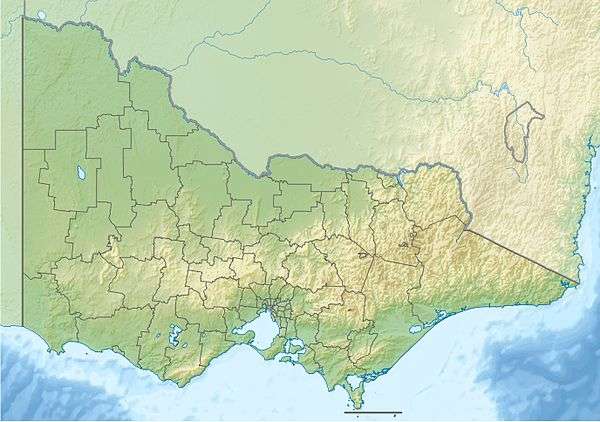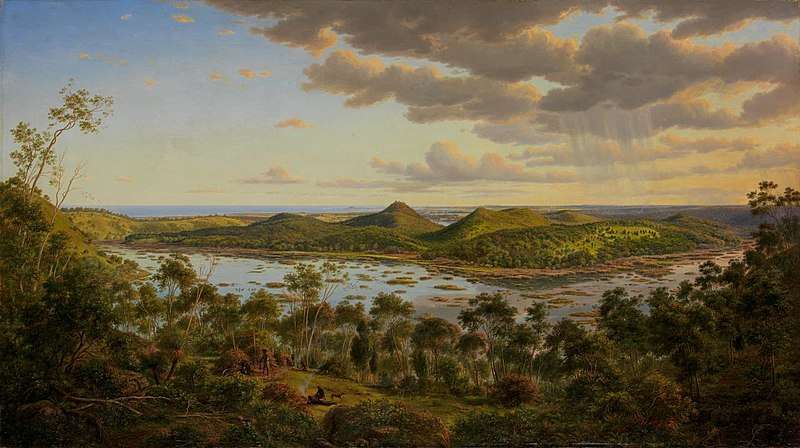Tower Hill (volcano)
Tower Hill is an inactive volcano on the south-west coast of Victoria, Australia, approximately 275 kilometres (171 mi) west of Melbourne, and 15 kilometres (9.3 mi) north-west of Warrnambool. Within the crater, the explosion also formed a series of small cones (known as scoria cones) and spheres surrounded by a crater lake. The Tower Hill crater is roughly 3 kilometres (1.9 mi) wide and 80 metres (260 ft) high, and as a giant maar (volcanic explosion crater), it is of international and national geological significance. It has a gradient of between 10% to 80% at the higher points. The Dhauwurdwurrung name for the volcano is Koroitj.[1]
| Tower Hill (Koroitj) | |
|---|---|
 Tower Hill (Koroitj) Victoria, Australia | |
| Highest point | |
| Elevation | 103 m (338 ft) |
| Coordinates | 38°19′17″S 142°21′35″E |
| Geography | |
| Location | Victoria, Australia |
| Geology | |
| Last eruption | 34,000 BP |
History
Aboriginal Australian kitchen middens at Tower Hill show 5000-year-old Tasmanian devil bones.[2] Greenstone axe heads and other artefacts excavated from the tuff indicated that Aboriginal people were resident in the area when the volcano erupted. A basalt tool dubbed the "Bushfield Axe", found buried under volcanic ash near Tower Hill in 1947, was particularly significant. The evidence also aligns with local people's oral histories of volcanic eruptions, indicating the longevity of and truth contained in such histories.[3] The Koroitgundidj people long inhabited this region of Australia and their descendants retain special links with the area.[4]
The most recent eruption was previously dated in 1990 as c.25,000 BP.[5] However, in February 2020, new evidence came to light by using a more sophisticated method of dating than previously, a form of radiometric dating known as argon-argon dating, showing that both Budj Bim and Tower Hill volcanoes erupted at least 34,000 years ago.[3] Specifically, Tower Hill was dated at within 3,800 years either side of 36,800 years BP. Significantly, this is a "minimum age constraint for human presence in Victoria", and also could be interpreted as evidence for the Gunditjmara oral histories which tell of volcanic eruptions being some of the oldest oral traditions in existence.[6] The study was carried out by the University of Melbourne's School of Earth Sciences' David Phillips and three other researchers.[3]
The first confirmed sighting of Tower Hill by Europeans was by French explorers sailing with Captain Baudin aboard Géographe in 1802. Matthew Flinders sailed east along the southern coast of Australia and on 20 April 1802 in the ship's log referred to "Peaked Hill Position uncertain", which may refer to Tower Hill.[7]
The Hill was painted by the artist Eugene von Guerard in 1855, who was the foremost landscape artist in the colonies at the time. The painting Tower Hill, 1855 [8] is now in the Warnambool art gallery.[9] The painting was used as a source of information of local native vegetation when an extensive revegetation project was undertaken in the Tower Hill Wildlife Reserve from 1961.[10]
Description
Located about 275 kilometres (171 mi) west of Melbourne and 15 kilometres (9.3 mi) north-west of Warrnambool, Tower Hill's formation is known as a "nested maar", the largest of its type in Victoria. It was created by molten lava pushing its way up through the Earth's crust, before hitting a layer of water-bearing rock, which led to huge explosions. A shallow crater was left, later becoming a lake after it filled with rainwater. Subsequent to this, later eruptions occurred in the centre of this crater-lake, pushing up islands and cone-shaped hills,[12] known as scoria cones.[13]
It is "one of the largest eruption points of the Pleistocene Newer Volcanics Province of Victoria". The main crater is 3.2 kilometres (2.0 mi) by 2.4 kilometres (1.5 mi). Within the steep-walled tuff ring is a crater with a depth of over 90 metres (300 ft). Because of the complex nature of its formation and structure, and as one of the largest maars in the world, it is of great geological significance both nationally as internationally.[13][12]
Tower Hill volcano is roughly 4 kilometres (2.5 mi) and 80 metres (260 ft) high, and as a giant maar (volcanic explosion crater), it is of international and national geological significance. It has a gradient of between 10% to 80% at the higher points.
Reserve
Now part of the state park system as the Tower Hill Wildlife Reserve, the area had been used since European settlement for farming and stone quarrying. The area has been reforested with native flora, and repopulated with native fauna since 1961
Location
The town of Koroit is on the north rim of Tower Hill, within easy reach of both Warrnambool and Port Fairy.

This lookout is located at approximate location from which he painted his Tower Hill, 1855 painting.


Visible are the scoria cones forming the 'islands' in the middle of the crater, and the lake and far rims of the larger crater.
Note the layering in the far right-hand side of the image.
See also
- List of volcanoes in Australia (active and dormant)
Notes
- Ian Clark, 'Reconstruction of Aboriginal microtoponymy in western and central Victoria' in Harold Koch and Luise Hercus (eds), Aboriginal Placenames: Naming and Re-naming the Australian Landscape (ANU E Press and Aboriginal History Incorporated, 2009) <http://press-files.anu.edu.au/downloads/press/p17331/html/ch08.xhtml?referer=xxxxxx&page=17>
- Owen, David; Pemberton, David (2005). Tasmanian Devil: A unique and threatened animal. Allen & Unwin. ISBN 978-1-74114-368-3. p.41.
- Johnson, Sian (26 February 2020). "Study dates Victorian volcano that buried a human-made axe". ABC News. Retrieved 9 March 2020.
- "Victorian Heritage Database". VHD. Retrieved 9 March 2020.
- Orth, K.; King, R. (1990). The Geology of Tower Hill. Department of Industry, Victoria. ISBN 0 7241 9733 8. p.3.
- Matchan, Erin L.; Phillips, David; Jourdan, Fred; Oostingh, Korien (2020). "Early human occupation of southeastern Australia: New insights from 40Ar/39Ar dating of young volcanoes". Geology. doi:10.1130/G47166.1. ISSN 0091-7613.
- "Site: Tower Hill (Vic)". Matthew Flinders and the Coastal Landforms of Southeastern Australia (website). Archived from the original on 23 July 2008. Retrieved 24 June 2008.
- Tower Hill
- "Site: Artist's Footsteps". Department of Education, Training and Youth Affairs (website). Retrieved 11 September 2015.
- "Tower Hill Reserve: History and Heritage". worngundidj.org.au. Retrieved 9 March 2020.
- "Tower Hill Reserve – History and Heritage" (PDF). Parks Victoria. Retrieved 9 March 2020. Cite journal requires
|journal=(help) - "History & Heritage". Tower Hill (Worn Gundidj Corporation). Retrieved 9 March 2020.
- "Tower Hill". Victorian Resources Online. Retrieved 9 March 2020.
This information has been obtained from the report: Eruption Points of the Newer Volcanic Province of Victoria by Neville Rosengren. This report was published in 1994 and was prepared for the National Trust of Australia (Victoria) and the Geological Society of Australia (Victorian Division). The review of eruption points was based on an earlier unpublished manuscript Catalogue of the post-Miocene volcanoes of Victoria compiled by O P Singleton and E B Joyce (Geology Department, University of Melbourne 1970).